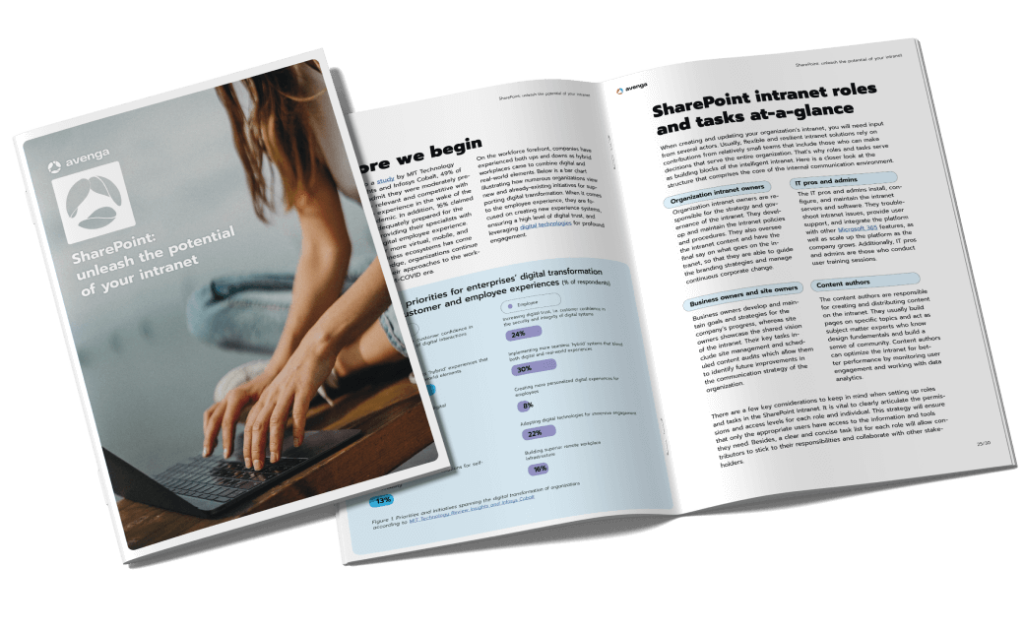To each their own
In an ‘inclusive’ intranet, the employee retains access to all the organizational tools, functions, and business processes. The fundamental change is simpler access and an even more personalized selection of content than before. News and updates are tailored to the individual roles, responsibilities, and interests of each team member. SharePoint Target Audience and Home Site features are used for tailored communication, which ceases to be a one-way transmission and becomes something like a personalized conversation.
The core of this personalized communication is SharePoint, which is used to create, organize, and select content. The employee doesn’t have to force their way through the SharePoint maze — everything they need is served to them via updates, notifications, or information on the intranet homepage.
User-friendliness, top-tier speed, and next-level customization can also be seen in the intranet search engine. Emails, team messages, documents, people, calendar events, and news — each item is searchable and instantly accessible. Refining wizards are tailored to each search source, filtering and narrowing the results down to the most precise and accurate ones. The data don’t have to be fully structured. For instance, the documents you search for can be filtered by type, creation date, author, or editor, and you can search for colleagues by position, department, or first name. You don’t need the names of documents or people’s last names.
Entire organization always at hand
Thanks to the integration of approvals from various intranet applications and task automation (Microsoft Power Automate service), an employee can get anything done remotely from the homepage. If they don’t know how to request leave or where to send an invoice, they’ll find out in seconds using the intranet. If they need approval of the cost of a company event or want to change suppliers, they’ll get it done through the intranet as well. It’s only enough to define the process in M365 — and there can be hundreds of such processes.
The integrated intranet interface does not require switching between applications. All relevant matters — such as tasks, approvals or requests — are at hand at all times. An intranet structured in this way not only reduces the number of clicks, but also ensures that content loads instantly. Thanks to powerful engines, even the first page load takes not more than milliseconds. For example, the size of images is immediately optimized for the device on which they are to be displayed. The loading time of all images after optimization is equal to the loading time of the largest image. This impressive performance is possible thanks to query clustering and cache systems.
All of the intranet solutions presented earlier also work in multi-cloud environments (e.g. Confluence and M365).
Explore options for tapping into the full potential of Microsoft 365 and learn how to reimagine your business with this multifaceted solution.
[Read an article]
Extended intranet: the characteristics
1. Universal accessibility
An intranet landing page as a PWA makes the phone a gateway to a world of real-time information. The enhanced Microsoft 365 environment can, of course, also be used on a tablet and PC. This gives employees immediate access to organizational news and updates, which lets everyone stay up-to-date, engaged, and empowered.
2. Seamless integration
In a landscape of digital tools and platforms, technology convergence is not just a nice-to-have — it’s a must. Tasks, approvals, requests, and links coexist not as isolated units, but as interconnected elements forming a harmonious ecosystem. Every task from MS ToDo, every request submitted via MS Users transitions from tasks to requests to approvals not by switching between applications, but in the form of a seamless, intuitive journey within a single interface.
3. Precision in reach
When extended, the intranet landing page uses SharePoint Target Audience and Home Site. This lets you accurately identify the recipients of the information distributed. News and updates are not only delivered efficiently, but are also tailored to each team member’s unique roles, responsibilities, and interests. What lies at the core of this personalized communication is the SharePoint homepage — a dynamic, interactive hub that organizes and selects content based on individual user profiles.
4. Much better search
No knowledge of information architecture is required for an effective, result-rich search. Emails, team messages, documents, people, calendar events, and news — each item is searchable. Search wizards guide the user through a curated journey, filtering and narrowing results down to the most relevant, most accurate, and most useful ones (personalized search).
5. The lightning speed performance
The intranet landing page loads in even under one second the first time. This unparalleled performance is made possible thanks to an innovative query clustering mechanism and an intelligent cache system. There’s no more efficient solution on the market right now.
6. Ultimate flexibility
Each element of the intranet landing page is designed as part of the SharePoint Internet Framework (SPFx), which translates into exceptional adaptability to the specifics of any organization and the preferences of any employee. Every feature, every component can be customized, rearranged, and personalized to fit your unique landscape. Changes can be made on an ongoing basis, depending on the organization’s needs and situation.
In an extended M365-based intranet, internal communication really ceases to be generic, one-size-fits-all, and becomes more like an individual conversation with each individual employee. On the other hand, it enables employees to use the intranet easily and intuitively, which results in, for example, a much better knowledge propagation.
Final words
To extend the Microsoft 365 environment, all you need is the cheapest license for this platform. Integrating and streamlining internal communications through the intranet doesn’t require any additional tools. For small and medium-sized intranets (50 to 800 users), individual components are connected almost immediately. Additional configurations are necessary only for multinational companies operating in markets governed by different regulations.
Internal communication calls more and more often for an integrated, personalized, smart, and innovative approach to support employees in jointly achieving organizational goals. It is crucial to use technology, data, and advanced communication methods in a way that is useful and advantageous to all employees.
The solutions covered in this article have been developed based on in-depth knowledge of Microsoft technologies. If you would like to learn more about intranet solutions for the M365 ecosystem, contact Avenga, a certified Microsoft Solutions Partner in the areas of data and AI, as well as digital and application innovation.










